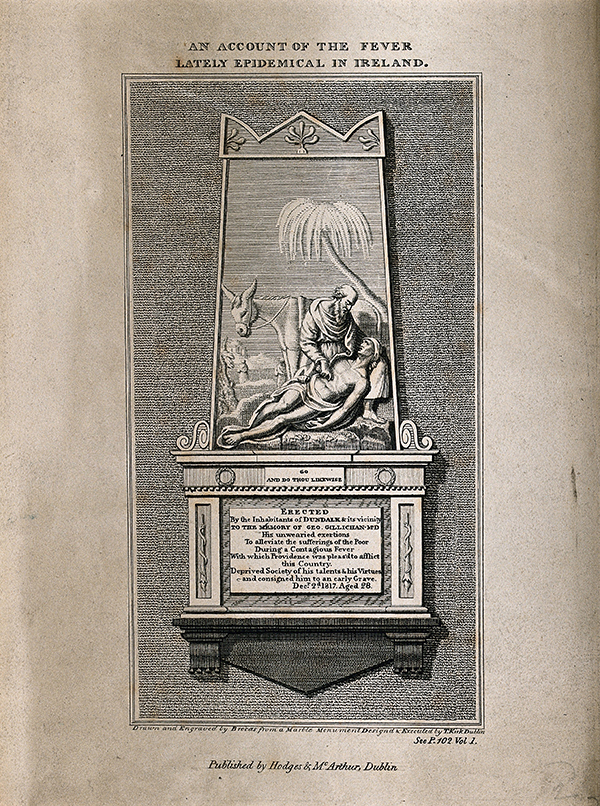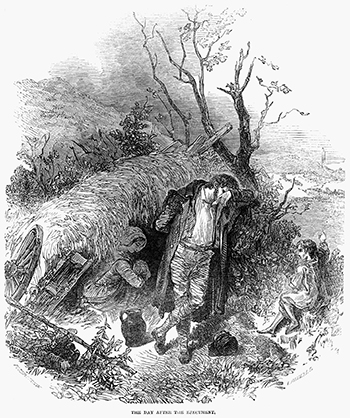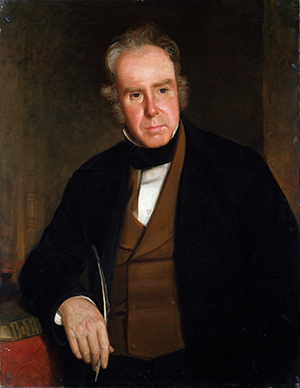Plus ça change?
Published in Features, Issue 2 (March/April 2021), Volume 29Epidemic disease and social reaction
By Laurence Geary
“Fear, mass panic and hysteria were features of all serious outbreaks of fever, cholera and other communicable diseases in early modern and modern Ireland.”
In the past, disease epidemics in Ireland provoked a very powerful social reaction, particularly outbreaks of the country’s deadliest infections: bacillary dysentery, cholera, smallpox, tuberculosis and ‘fever’, a term which, prior to the twentieth century, embraced typhus fever and relapsing fever, two distinct but symptomatically related bacterial infections.
The ‘forgotten famine’
Fever was endemic in Ireland, killing and terrifying countless thousands from the early medieval period onwards. In the eighteenth century the most lethal epidemic was linked to a devastating famine in 1740–1, the so-called ‘forgotten famine’. Hordes of wandering beggars disseminated malignant fever, bacillary dysentery and smallpox to the country’s outermost reaches in the summer of 1740, and the virulency of the infections intensified in the following year. Estimates of starvation and famine-related disease mortality in the years 1740–1 vary from 80,000 to five times that number. Demographers and historians now tend to the upper reaches, suggesting that between 250,000 and 400,000 excess deaths occurred during the two years of crisis. In relative terms, the 1740–1 famine was at least as severe as the Great Hunger a century later.
Subsequently, major fever epidemics were associated with the 1798 Rebellion and with a crippling economic depression that followed Napoleon’s defeat in 1815 and the conclusion of a lengthy period of European warfare. Fever spread among civilians and troops in the wake of the 1798 Rebellion. Climatic extremes, deficient and poor-quality harvests, and rapidly rising food prices exacerbated the situation. The wretched state of the Irish poor at the turn of the nineteenth century worsened after 1815, when wartime buoyancy was followed by economic collapse, famine and fever. Between late 1816 and 1819 as many as 1,500,000 Irish people may have contracted the disease, with between 40,000 and 60,000 excess deaths.
Quarantine and ‘fever huts’
The organisms that cause fever were not identified until early in the twentieth century, but it was generally conceded from a much earlier period that poverty, hunger, domestic overcrowding and poor sanitation were predisposing factors. Irish people were empirically aware of the disease’s symptoms, consequences and infectivity, and fear of contagion drove them to quarantine fever victims. It is impossible to say when the practice began but it was firmly established by the opening decades of the nineteenth century, with families’ economic and social circumstances determining the method. The middle and upper classes’ domestic arrangements enabled segregation of the sick within family homes, though this was largely ineffectual, as isolation within households did little to stem the spread of infection.
The rural poor in their one-roomed cabins isolated fever-stricken family members in ‘fever huts’, which were hastily improvised at the side of a road, the corner of a field or the verge of a bog. These shelters consisted of a few stakes, covered with long sods called ‘scraws’ and a small portion of straw or rushes. Some were even more rudimentary, consisting simply of straw and furze tied together and placed at an angle to the ditch, an arrangement that could be adapted to the prevailing wind. These wretched structures were probably a variation of the ‘scailps’ or ‘scalpeens’ in which evicted tenants and other homeless people traditionally sought refuge. Tim Robinson, in his 2003 essay ‘Scailp’ about an eponymous place in Roundstone bog in Connemara, stated that ‘a scailp can be a cleft or small cliff, a clump of bushes or briars, a hut roofed with sods of turf, and so on—any one of a variety of poor nesting places’. Terence Patrick Dolan, in A dictionary of Hiberno-English. The Irish use of English (Gill Books, 3rd edn, 2020), p. 209, defined a ‘scailp’ as ‘a crude shelter made of sods etc. erected for travellers in need of protection from the elements; a rude cabin’.
William Carleton’s depiction
William Carleton’s ‘The Poor Scholar’, from his 1830 collection Traits and stories of the Irish peasantry, offers an authentic contemporary account of the context and process of segregating infected poor people in pre-Famine rural Ireland. Carleton observed that the Irish were ‘particularly apprehensive of contagious maladies’, and experience had acquainted them with the symptoms and consequences of fever. Jemmy McEvoy, the poor scholar of the title, was ‘avoided like a Hebrew leper of old’ after he became infected, shunned by his schoolfellows ‘with a feeling of terror scarcely credible’, and compelled to leave the school. A group of agricultural labourers discovered Jemmy’s inert body lying by the roadside and, though they shared the general dread of fever, they agreed to help him, persuaded by their religious conviction that those who assisted such an individual would receive ‘a great blessing’. Thus fortified, the labourers contrived ‘a little shed’, a shelter consisting of ‘a few loose sticks covered over with “scraws”’, a dialect word which Carleton defined as ‘the sward of the earth pared into thin stripes’. The labourers placed Jemmy on a scattering of straw within and plied him with food and drink by means of a pitchfork and a long-shafted shovel, a common practice at the time to avoid coming into personal contact with an infected individual. ‘The ragged, half-starved creatures laughed heartily at the oddity of their own inventions’, in Carleton’s romanticised account, ‘and enjoyed the ingenuity with which they made shift to meet the exigencies of the occasion.’

Frontispiece engraving on F. Barker and J. Cheyne’s report (1821), showing a monument representing the Good Samaritan, erected in honour of Dr George Gillichan of Dundalk, who died ministering to the sick ‘during a contagious fever’ in 1817. (Wellcome Collection)
‘The Poor Scholar’ provides an accurate depiction of the nineteenth-century social reality of fever huts and quarantine practices among the rural poor in Ireland; similar stratagems were widely reported during the 1816–19 fever epidemic and the Great Famine of the 1840s. As contemporary accounts attest, however, Carleton gilded and glossed the labourers’ benignity; the springs of charity rarely proved strong enough to overcome the terror felt by those who had to pass by or tend a fever hut—or, indeed, hospitals and other institutions ministering to people suffering from fever and other communicable diseases.

Above: An evicted family in a Great Hunger-era ‘scailp’ or ‘scalpeen’—similar to the ‘fever huts’ used to quarantine the poor in earlier times. (Alamy)
During the 1816–19 fever epidemic, communities throughout Ireland attempted to ward off infection in various ways. Some parishes and towns denied entry to strangers and occasionally posted armed enforcers at the approaches. Others expelled individuals who were not locally born or resident for the requisite qualifying period. In some Leinster counties, public notices warned against the practice of assisting or sheltering beggars and vagrants because of their perceived role in spreading infection. In Ulster paupers were required to wear identity badges.
Remedies
The general apprehension manifested itself in other social and psychological ways. Ambulance attendants conveying fever patients to isolation hospitals wore ‘a peculiar dress’ and their vehicles were said to be of ‘a remarkable construction’, the oddity of design and apparel clearly prompted by fear of infection. Placards advertising ‘thieves’ vinegar’, a prophylactic that may have originated during the Black Death pandemic in the Middle Ages, were posted in various parts of Dublin, with the word ‘fever’ graphically portrayed. Various nostrums were touted as preventives, including camphor, which was in great demand and sold in large quantities.
Fear was the predominant—though not the sole—determinant of communal feeling and action. In the countryside, apprehension and dread were tempered by a more generous impulse, a concern for the common good. It was customary in rural Ireland—though seemingly not in major urban areas—to attach a symbol or token to houses with fever-stricken occupants as a warning to passers-by. ‘In the country,’ according to one contemporary, ‘the poor are in the habit through a religious motive of drawing a large red cross upon their doors, either with tar or red paint, when any of the family are afflicted with fever, which answers as a sign to the passengers.’ The principle of alerting the public to the presence of fever in households by appending a clearly visible sign to the exterior was enshrined in parliamentary legislation in 1818.
‘The blessed turf’

Above: William Carleton (1794–1869)—his writings, including ‘The Poor Scholar’ (1830) and The Black Prophet (1847), contain vivid empirical accounts of fever in nineteenth-century Ireland. (NGI)
Perhaps the most striking manifestation of the popular response to disease epidemics occurred in 1832, when cholera—a bacterial disease usually spread through contaminated water—affected Ireland for the first time, part of a global pandemic that originated in India. This was the incident of ‘the blessed turf’, also known as ‘the sacred fire’ or simply ‘the fire’, which began on the evening of 9 June 1832 with the reputed appearance of the Virgin Mary in the Catholic church at Charleville, Co. Cork. According to contemporary reports, Mary distributed ash as a prophylactic against cholera among those who were present. Each recipient was to place a portion under the roof of their home and to divide the remainder among four neighbours, with instructions to replicate this procedure. Within days, large numbers of people were subsumed in the excitement and the message spread rapidly from north Cork to other parts of the country. The process was a verbal one in a pre-literate society, which meant, inevitably, that there were changes in tenor and tone as the information passed from place to place at great speed, and items such as sods of burning turf, lighted straws or stones were substituted for ash in some locations.
Fever had been a pervasive presence in Irish life for centuries, but cholera was new, mysterious and deadly. Its symptoms were frightening—victims’ skin turned blue or purple, for example (see ‘THE APPEARANCE AFTER DEATH OF A VICTIM OF THE INDIAN CHOLERA’, HI 28.4, July/August 2020, p. 25)—its course was unpredictable and it killed quickly, features that combined to introduce a fresh terror into Irish society, so intense that it sparked riots in some urban centres. As in other parts of Europe, there was a popular belief that the epidemic was not a natural occurrence, and rumours circulated regarding agency and responsibility. Some people accused the government of attempting to rid the country of the poor by poisoning water and food supplies, with discoloration of corpses offered as proof. Others claimed that the epidemic was a contrivance of the medical profession to generate patients and income. A third element pinned responsibility on avaricious merchants and traders actuated by the prospect of inflated food prices.
Wakes, weddings and funerals censured
Visitations of disease, such as fever in the immediate post-Napoleonic years and cholera in the early 1830s, were marked by confusion and panic in Ireland and elsewhere, and threatened political and social stability. The Catholic hierarchy and clergy, who ministered to the peasantry and the disadvantaged in Irish society, were concerned about the well-being of their flocks and the maintenance of social order. In times of crisis the Catholic Church acted in concert with the civil authorities, and the clergy used their office and their pulpits to preach the medical profession’s and the government’s public health message. Church and State decried the custom of extending hospitality and accommodation to beggars and vagrants, who were widely blamed for disseminating fever and other communicable diseases. Social and religious gatherings, particularly wakes, funerals, weddings and patterns, were censured as occasions of infection and licence, notorious for excessive consumption of alcohol, a practice which, according to medical opinion at the time, was responsible for physical and mental debility, susceptibility to disease and the spread of infection.
In April 1832, at the height of the cholera pandemic, the Central Board of Health for Ireland, a government advisory body, counselled the public not to hold or attend wakes and warned against intemperance as a predisposing cause of cholera. The Catholic Church supported both injunctions. In a pastoral letter, Archbishop Daniel Murray of Dublin urged individuals to abstain from alcohol, ‘lest the body should fall a victim to premature disease and the unhappy soul to that sentence which declares that drunkards shall not possess the kingdom of God’, and, he pronounced, any Catholic who ignored the board’s advice regarding wakes and who subsequently contracted cholera fatally would be guilty of suicide, self-murder, which in Catholic eschatology had implications for burial in hallowed ground and for the afterlife.
Fear, mass panic and hysteria were features of all serious outbreaks of fever, cholera and other communicable diseases in early modern and modern Ireland, a communal reaction that was largely attributable to pre-scientific medical ignorance, fear of the unknown, and the economic and social implications of infection. People did not know how these maladies were caused and, by extension, how to cure them, and they feared what they did not know and could not control. What they were very much aware of was the impact and consequences of infectious diseases, which, if they did not kill their victims, often reduced them and their families to penury, the workhouse and social degradation.
Economic, social, medical and scientific advances in the second half of the nineteenth century and subsequently helped to suppress fever and other infectious diseases, but the fear and mass panic that invariably featured during outbreaks historically in Ireland did not pass entirely. The ‘Spanish ’flu’, tuberculosis and polio generated their own share of popular hysteria in twentieth-century Ireland, and the more recent response to the HIV/AIDS epidemic and currently to Covid-19 shows that society’s primordial fears have not been entirely allayed.
Laurence Geary lectured in Irish history at University College Cork prior to his retirement.
FURTHER READING
F. Barker & J. Cheyne, An account of the rise, progress and decline of the fever lately epidemical in Ireland, together with communications from physicians in the provinces, and various official documents (2 vols) (Dublin, 1821).
W. Carleton, ‘The poor scholar’, in Traits and stories of the Irish peasantry (Dublin, 1830).
J. Robins, The miasma: epidemic and panic in nineteenth-century Ireland (Dublin, 1995).
















